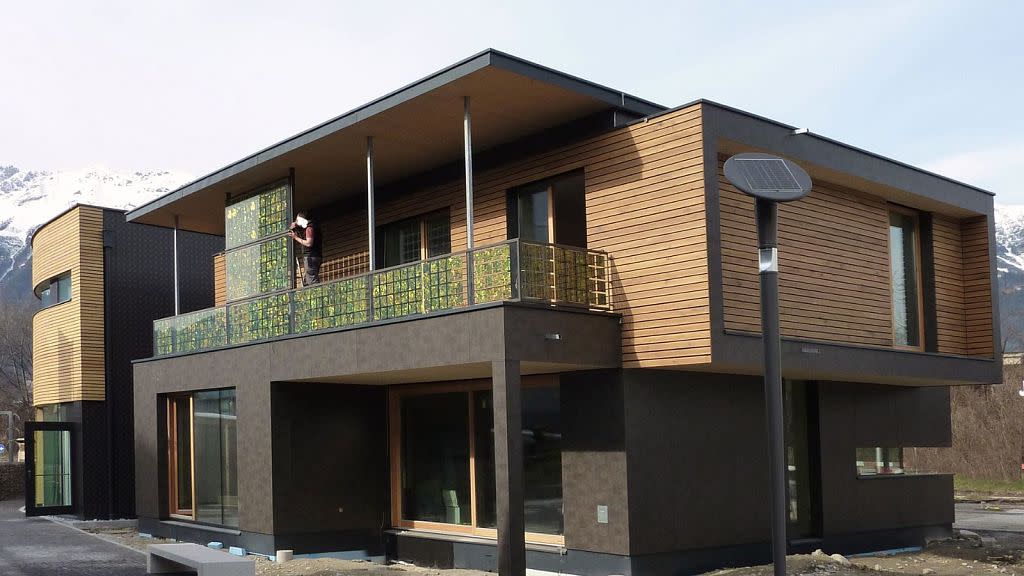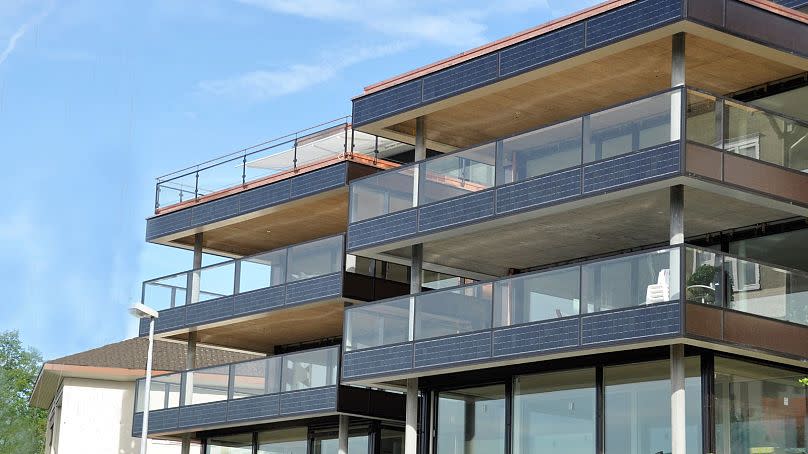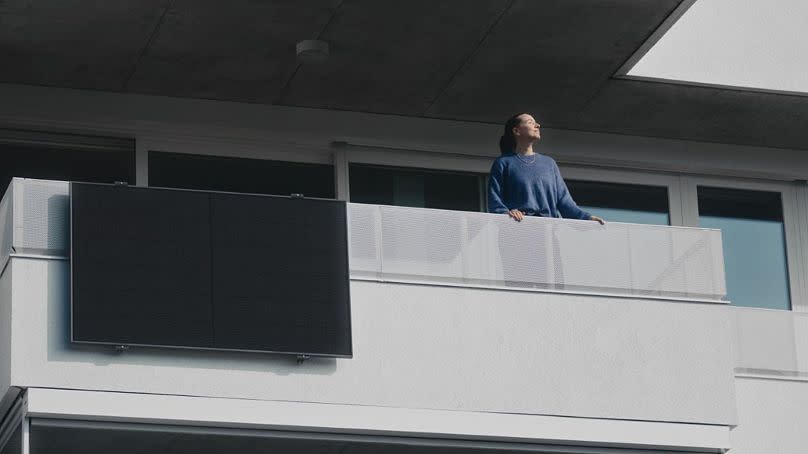Solar balconies are booming in Germany. Here’s what you need to know about the popular home tech

More than 400,000 plug-in solar systems have been installed in Germany, most of them taking up a seamless spot on people’s balconies.
New data shows at least 50,000 of the PV devices were added in the first quarter of 2024 alone. A boom born from Germany’s “very strong solar culture”, in the words of one expert.
Solar balconies are a piece of the wider energy transition across Europe, explains Jan Osenberg, a policy advisor at the SolarPower Europe association.
“We see them as a subset of rooftop solar, but also as something different,” he tells Euronews Green. “We basically see it as a trend to use all possible artificial infrastructure for solar generation.”
Train tracks, motorways, carparks, car roofs, cemeteries and building facades… the list of structures getting a solar makeover goes on and on.
So why are other European countries slow on the balustrade uptake? And what do you need to know if you’re eyeing up a panel or two for your balcony?
Two countries in Europe are powered by 100% renewable energy as wind capacity soars
From four walls to four wheels: How we live sustainably, from electricity use to food waste
Solar balconies in brief: How they work
The main thing that differentiates solar balconies from rooftop solar is that they’re a much smaller system. Essentially, the tech consists of one or two panels plugged into an electricity socket.
They only produce around 10 per cent of the energy of residential rooftop systems, Osenberg says.
As a rough calculation, he estimates Germany has around 200 MW of installed balcony solar; compared to 16 GW capacity from the residential roof sector.

From a customer point of view, the main difference is that balcony PV is much easier to install. You can buy the kit online, and don’t need an electrician to set it up. Unlike for rooftop installations, where certified installers are recommended to avoid fire risks and damage to the structure.
In short: the panels are put on a mounting structure and attached via cables to an inverter that converts the electricity from DC to AC, which goes into your socket via a regular plug.
Who are solar balconies for?
“The main reason for the success of balcony solar systems is that it gives people the chance to use solar who weren’t able to use it before,” says a spokesperson for German manufacturer Meyer Burger.
“Most people don’t own a house, or they cannot install rooftop solar because of heritage protection, shading, or other constructional conditions of the roof. For them, balcony solar is appealing because they can use solar power to generate their own electricity and reduce their electric bills.”
Germany was one of the first countries to invest in solar technology, and now produces the most electricity from solar power in Europe. But - as elsewhere - apartment blocks have been late to the party.
“The multi-dwelling unit sector in rooftop solar has been really outside of the solar boom, [it] has been really neglected,” says Osenberg.
He attributes this to the challenges involved in getting all building owners to agree to rooftop solar, for example, and difficulties in sharing the electricity between different apartments.
“With balcony solar,” however, “it's suddenly very, very simple. All these people who were not able to get solar for the past 10 years now have a way to access it.”
This “wave” of new solar owners aren’t simply benefiting from cheap electricity, Osenberg says; they’re also empowered to take up their place in the energy transition.
“Rooftop solar really has this empowering momentum that people who start to have a solar system, they start to track their electricity consumption, they start to feel themselves as being someone who is a frontrunner in the energy transition, someone who supports the energy transition and is already a part of it” he says.
How has Germany helped people get balcony solar?
Germany was ahead of the curve on rooftop solar in the 2000s. The government encouraged people to get involved by rewarding them with feed-in tariffs, for example, giving a fixed price for every unit of electricity sent to the grid.
“Customers had already started this boom and successfully demanded simplified bureaucracy from politics,” according to Meyer Burger’s spokesperson. “Measures such as the elimination of VAT contributed to the popularity of balcony solar.”

Subsidies are also available on a regional level, with up to €500 on offer in Berlin (potentially half the cost of a kit). The tech pays for itself after around three years, says Osenberg. So with a lifetime of around 20 years, “it’s a very straightforward investment for citizens.”
According to the market master data register, North Rhine-Westphalia currently has the most plug-in solar systems with well over 80,000, followed by Bavaria with more than 60,000 and Lower Saxony with more than 50,000.
The size of balcony solar systems is also gradually increasing, adds Osenberg. The German government is now looking to enable up to four panels.
Why are other countries’ ‘missing out’ on balcony solar?
The EU has said that member states can aid the adoption of balcony solar. But it’s not mandatory, and it’s not been embraced by all countries.
Belgium, notably, has banned plug-in solar devices over fears about the impact of having unregistered systems feeding into the electricity grid.
Grid operators want to have oversight of electricity supply, as sudden changes can lead to a power failure. “But in our view this is not really an issue,” explains Osenberg, “because the injection from the balcony system is so small that the impact would also be quite negligible.”
Austria, France, Italy, Poland and Luxembourg have all taken an encouraging stance towards balcony solar. While renewable energy campaigners in Spain are seeking to get their government to loosen the rules soon.
Things to bear in mind before buying balcony solar
There’s constant innovation on the solar scene, of course - and balconies are no different. If you’re tempted to join in, here are some things to note.
Small-scale storage is an option. Although these systems don’t tend to produce much excess electricity, more makers are offering storage systems for balcony specific solar. The batteries - which fit in between the panels and inverter - are smaller than for rooftops, but still handy for people working away during the day who can use the stored energy come evening.
Apps can help track your electricity usage. Some kits come with apps, allowing you to see how much electricity your PV system is producing, and how much of your energy demand they meet. These are hosted on secure servers, so your digital protection isn’t compromised.
Ensure your kit is sustainably manufactured. For Meyer Burger, this means the panels “do not contain lead or other toxic substances [like PFAS], and are produced without forced labour under decent social and ethical standards.”
There are options to rent a balcony solar system. And of course the beauty of this plug-in system is that if you are renting an apartment, you can take it with you when you move on.
Balcony systems still need to be safely mounted. Although they encourage a DIY approach, you need to take the installation seriously, says Osenberg. Hook designs make it simple, but as the modules weigh up to 24kg, they could cause serious damage if dropped from the 10th floor.

